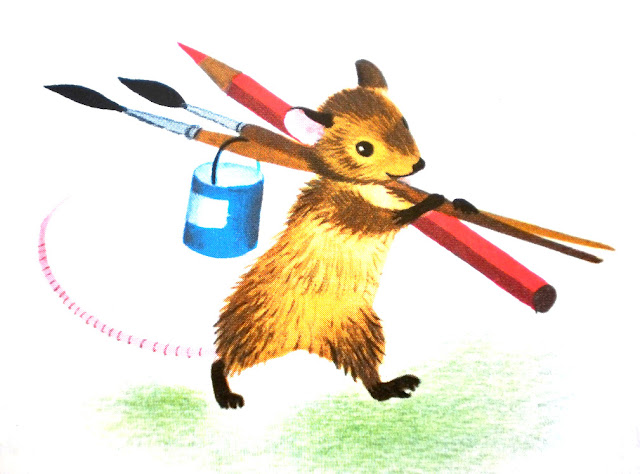Brushflurlet
Last week I gave two lectures about the early 20th century avant-gardes, one of my favorite
graphic design history subjects. While animal representations and children's books
are not commonly found in the work of these artists, there are a few notable exception,
Höch was one of the few women to participate in the Dada movement, and one of the main members
of its Berlin group. Born in Germany in 1889, she studied graphic arts in Berlin and left school to work
for the Red Cross during WWI. In 1915 Höch had begun a close friendship with the Dadaist artist
Raoul Hausmann, and at the end of the war she became involved with the movement.
She studied fabric design and textiles, and while working part time for the large publisher Ullstein Verlag,
she used the company's catalogues to create her early photomontages. Höch and Hausmann
became pioneers of this new art form, which they used for political satire and social commentary.
Höch and Hausmann in 1920 at the First International Dada Fair. She was the only woman in the show.
The large photomontage at left is Cut with the Kitchen Knife through the Beer-Belly
of the Weimar Republic, Höch's most famous work.
In 1922 Höch separated from Hausmann and the Berlin Dadaists. She continued to produce her own art,
focusing more on feminist and gender issues. After the Nazis took power she remained in Berlin,
living in a remote area and keeping a low profile while protecting her artworks and Dada memorabilia.
She continued to produce and exhibit photomontages until her death in 1978 at the age of eighty-nine.
Boa Perlina
Langfransens
Rennquicke
Liebkübchen
In 1945 Höch created 19 photocollages to illustrate her Bilderbuch (Picture Book), a story of fantastical creatures
set in a dreamy fairy tale garden, which remained unpublished until 1985. As Gunda Luyken
writes on the website of The Green Box, the German publisher which recently reprinted the book:
"To counter the grey postwar years, Höch developed in 19 collages and accompanying texts
a magical world populated by fantastic exotic plants and animals. People play no role here,
apart from the baby emerging from one of the eggs that Madame Marklet has collected around her.
... Although Höch always spoke of her 'picture book', the texts are an essential part of the work.
For each of the collages, the artist thought up brief, delicate rhymes that sketch out miniature stories
and are reminiscent of the verses of Joachim Ringelnatz or Christian Morgenstern.
She gave her impish creatures the oddest names—Loftylara, Brushflurlet, Unsatisfeedle
and Runfast. Although Höch conjured up in images and words a fantastic world, it is one not free
of human weaknesses like dissatisfaction or disagreement, as represented, for example, by the couple Longfringes.
All the same, the book exudes a cheerfulness and light-heartedness that the philosopher and writer
Salomon Friedländer also attributed to the artist herself: 'Basically, you are a fabulous and wonderful girl—
and whoever doesn’t get you must be a dull and totally impossible guy.
And who does understand you? A child, just like you.'"
Schnifty
Schwanzgemsen
Unzufriedel
Dumblet and her Egg
Unsatisfeedle
Santaschwebe













.jpg)
















































